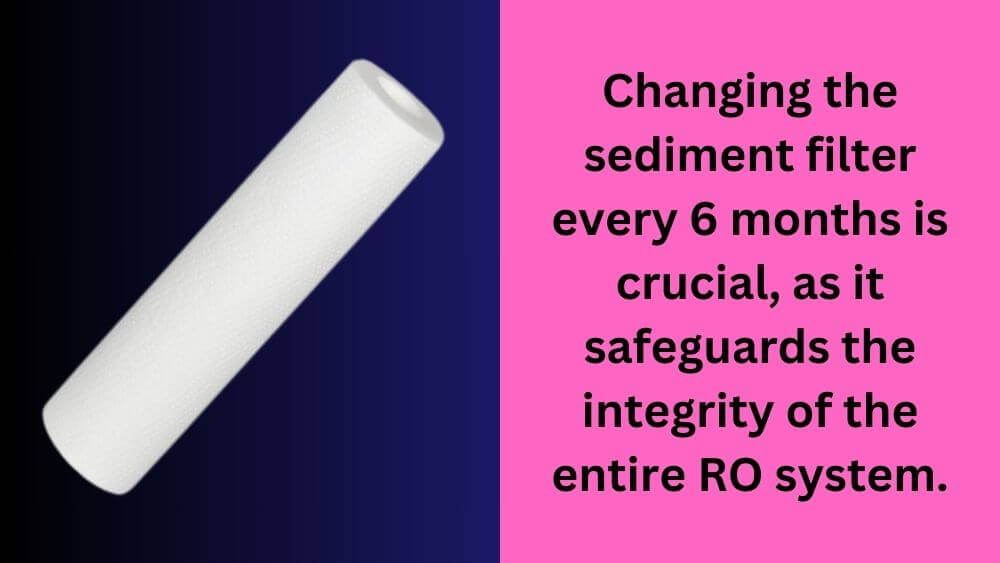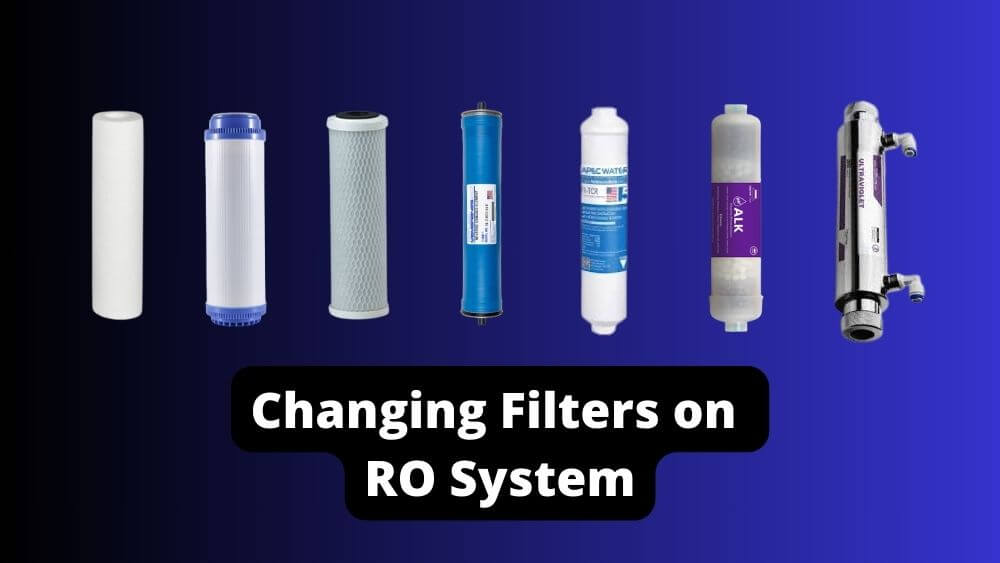Unlike other filtration systems, reverse osmosis requires regular maintenance. Therefore, we should change Reverse Osmosis filters regularly to maintain safe water flow.
The replacement of RO system filters does not have an exact duration. The period may vary depending on the quality of the source water. Changing these filters on a regular basis will prolong the life of your RO system and ensure that your drinking water is as safe as possible.
All other filters, except the reverse osmosis membrane, need to be changed every 6 to 12 months, including the sediment filter, activated carbon filter, polishing filter, and mineral and alkaline filter.
Generally, Reverse Osmosis filtration systems consist of four to seven stages. It is not necessary to change all filters at once. There are different absorbents and lifetimes for different stages of filters. Depending on the quality of your water, these filters may last longer or shorter.
When to change sediment filters?
Every six months to a year, you should replace your sediment filter. As soon as you realize that the RO filter output is low, the water pressure decreases. Then you should change our sediment filter because a clogged sediment filter causes law RO water output.
Polypropylene (PP) filters, known as sediment filters, are a type of porous filter made from thermoplastics. Generally, it is used as the first stage of RO water purification. In this stage, insoluble particles (soil, sand, silt, organic waste, etc.) are removed from the water.
For home use, sediment filters are available in lengths of 5 inches, 6 inches, 8 inches, and 10 inches. In addition, sediment filters on the market have pore sizes ranging from 0.45, 1, 5, and 10 microns and weights of 70, 80, 100, 120, and 150 grams.
When to change carbon filters?
Ideally, it would be best if you replaced carbon filters every year. The lifespan of a chlorine absorbent depends on its level of absorption.
By measuring the iodine number of activated carbon, you can determine how effective it is. Carbon’s iodine number describes how much Iodine it can absorb in milligrams per gram. In addition to iodine number, purity, absorption capacity, effective range, fineness of pores, etc., are also expressed. Through this stage, negative ions and odors are removed from the water.
Various types of carbon filters are available on the market, each with a different amount of Iodine. Iodine, for instance, is 300, 800, 1100, and 1200. High-quality active carbons are Iodine – 1100 and Iodine – 1200.
When to change the Reverse Osmosis membrane?
The Reverse Osmosis membrane has to change every 2 to 3 years. But its lifetime depends on the quality of the source water. Also, if the sediment and carbon filters are changed timely, the lifespan of the RO membrane will increase. On the other hand, if your water output suddenly becomes low, it is a sign that at least one of the filters isn’t working correctly.
The Reverse Osmosis membrane is the mother organ of the RO system. It is a semi-permeable membrane with tiny pores of 0.0001 microns. A booster pump applies intense pressure to the RO membrane to force water through the membrane. Since the membrane’s pore size is 0.0001 micron, all substances and ions larger than the pore size are trapped.

When to change the polishing filter or post-carbon filter?
You should replace this polishing filter or post-carbon filter every 1-2 years. Only purified water passes through the polishing filter, so it doesn’t need as much work as the other filters.
The post-carbon filter (also called the T-33 filter) contains activated carbon powder. As a result of this stage, the taste of the water is enhanced, and the clarity is maintained.
When to change the mineral and alkaline cartridges?
You need to replace your mineral cartridge every year. If you use an alkaline filter, the duration is the same as the mineral cartridge. Changing the mineral and alkaline filter from time to time will ensure the perfect level of minerals in RO water. Also, viruses, bacteria, and algae are less likely to grow.
Reverse Osmosis (RO) eliminates all harmful substances and ions from water and, unfortunately, some helpful minerals. Mineral cartridge helps to remineralize the water. On the other hand, an alkaline filter helps to maintain the PH level from 6.5 to 7.5.
When to change UV lamps?
It would be best if you replaced UV lamps once every 12 months. UV lamps have a lifespan of approximately 9,000 to 10,000 hours. This means the UV lamp can last for a little more than a year.
An RO water purifier has a UV filter chamber. Using ultraviolet rays destroys organisms in the water. The Ultra Violate Lamp emits Ultra Violate rays into the water using the electric power within the tube chamber. This ray immediately kills all organisms under its influence.
| Filter Name | Changing Duration |
| Sediment filters | Every Six Months |
| Carbon Filters | Every Year |
| RO Membrane | 2-3 Years |
| Polishing Filters | Every Year |
| Mineral Cartridge | Every Year |
| UV lamps | 9000 Hours |
Frequently Asked Questions
What happens if you don’t change sediment?
Neglecting to change the sediment filter on schedule can adversely affect your RO system. As it accumulates debris and particles, the filter can become clogged, reducing the system’s water output. This not only affects the availability of purified water but also allows dirt to reach the sensitive RO membrane, potentially shortening its lifespan and diminishing the overall effectiveness of your water purification system.
Why is periodic maintenance of the RO system necessary?
The Reverse Osmosis system can last more than a decade. Its lifespan can increase if the parts and filters are replaced from time to time. Regular maintenance increases the lifespan of the RO machine and ensures the safest water. The expired filters can be clogged and reduce the water flow. Also, expired filters can grow bacteria.
How long should you run water after changing any filter?
Immediately you can run your RO system. There is no doubt your water is safe. We recommend throwing away the first tank of water if you just purchased the whole system.
Will old UV lamps affect water quality?
Yes, an aged UV light can affect the water quality. A UV lamp sustains 9000 hours to 10000 hours. After that duration, its low beam can not kill germ accurately.
Can I turn my UV system off when I’m not using it?
Yes, you can. However, be careful if you forget to turn it on next time, your water may not be completely safe. On the other hand, frequent turns on/off will reduce the lifespan of the UV lamp.
How often should I empty my reverse osmosis tank?
If you use your RO system regularly, you should empty the air-tight RO storage tank every month. It will help you maintain safe water and keep the water pressure as the RO membrane requires.
Final Words
Replacing Reverse Osmosis filters from time to time ensures optimal effectiveness of your whole system and safe water. Otherwise, your RO system won’t provide safe water, and the system’s lifespan will decrease significantly.

Hasan Al Sarker is a Reverse Osmosis Specialist. He has worked for many years to ensure safe drinking water for all. His research paper has been published in several journals, including Issue, Medium, and Slideshare. He is recognized as a water doctor among specialists though he did not attend medical college.
Besides working as a researcher of reverse osmosis technology, he is also very fancy with the kitchen and cooking. His guides are reading thousands of people every day. As a head of content, he is responsible for all the published articles at RO System Reviews.

